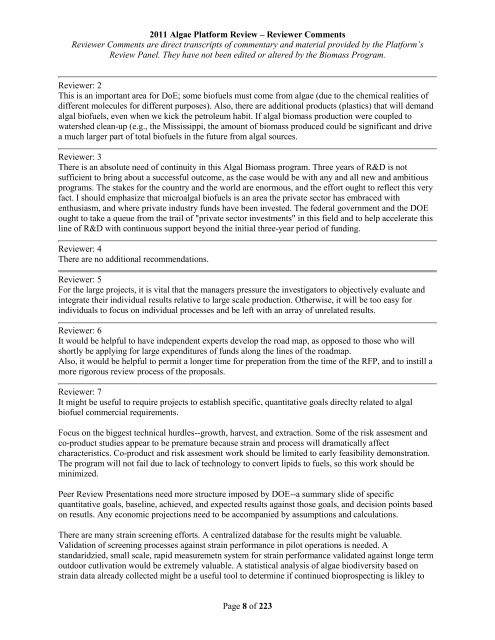Reviewer Comments - EERE
Reviewer Comments - EERE
Reviewer Comments - EERE
Create successful ePaper yourself
Turn your PDF publications into a flip-book with our unique Google optimized e-Paper software.
2011 Algae Platform Review – <strong>Reviewer</strong> <strong>Comments</strong><br />
<strong>Reviewer</strong> <strong>Comments</strong> are direct transcripts of commentary and material provided by the Platform’s<br />
Review Panel. They have not been edited or altered by the Biomass Program.<br />
<strong>Reviewer</strong>: 2<br />
This is an important area for DoE; some biofuels must come from algae (due to the chemical realities of<br />
different molecules for different purposes). Also, there are additional products (plastics) that will demand<br />
algal biofuels, even when we kick the petroleum habit. If algal biomass production were coupled to<br />
watershed clean-up (e.g., the Mississippi, the amount of biomass produced could be significant and drive<br />
a much larger part of total biofuels in the future from algal sources.<br />
<strong>Reviewer</strong>: 3<br />
There is an absolute need of continuity in this Algal Biomass program. Three years of R&D is not<br />
sufficient to bring about a successful outcome, as the case would be with any and all new and ambitious<br />
programs. The stakes for the country and the world are enormous, and the effort ought to reflect this very<br />
fact. I should emphasize that microalgal biofuels is an area the private sector has embraced with<br />
enthusiasm, and where private industry funds have been invested. The federal government and the DOE<br />
ought to take a queue from the trail of "private sector investments" in this field and to help accelerate this<br />
line of R&D with continuous support beyond the initial three-year period of funding.<br />
<strong>Reviewer</strong>: 4<br />
There are no additional recommendations.<br />
<strong>Reviewer</strong>: 5<br />
For the large projects, it is vital that the managers pressure the investigators to objectively evaluate and<br />
integrate their individual results relative to large scale production. Otherwise, it will be too easy for<br />
individuals to focus on individual processes and be left with an array of unrelated results.<br />
<strong>Reviewer</strong>: 6<br />
It would be helpful to have independent experts develop the road map, as opposed to those who will<br />
shortly be applying for large expenditures of funds along the lines of the roadmap.<br />
Also, it would be helpful to permit a longer time for preperation from the time of the RFP, and to instill a<br />
more rigorous review process of the proposals.<br />
<strong>Reviewer</strong>: 7<br />
It might be useful to require projects to establish specific, quantitative goals direclty related to algal<br />
biofuel commercial requirements.<br />
Focus on the biggest technical hurdles--growth, harvest, and extraction. Some of the risk assesment and<br />
co-product studies appear to be premature because strain and process will dramatically affect<br />
characteristics. Co-product and risk assesment work should be limited to early feasibility demonstration.<br />
The program will not fail due to lack of technology to convert lipids to fuels, so this work should be<br />
minimized.<br />
Peer Review Presentations need more structure imposed by DOE--a summary slide of specific<br />
quantitative goals, baseline, achieved, and expected results against those goals, and decision points based<br />
on resutls. Any economic projections need to be accompanied by assumptions and calculations.<br />
There are many strain screening efforts. A centralized database for the results might be valuable.<br />
Validation of screening processes against strain performance in pilot operations is needed. A<br />
standaridzied, small scale, rapid measuremetn system for strain performance validated against longe term<br />
outdoor cutlivation would be extremely valuable. A statistical analysis of algae biodiversity based on<br />
strain data already collected might be a useful tool to determine if continued bioprospecting is likley to<br />
Page 8 of 223




